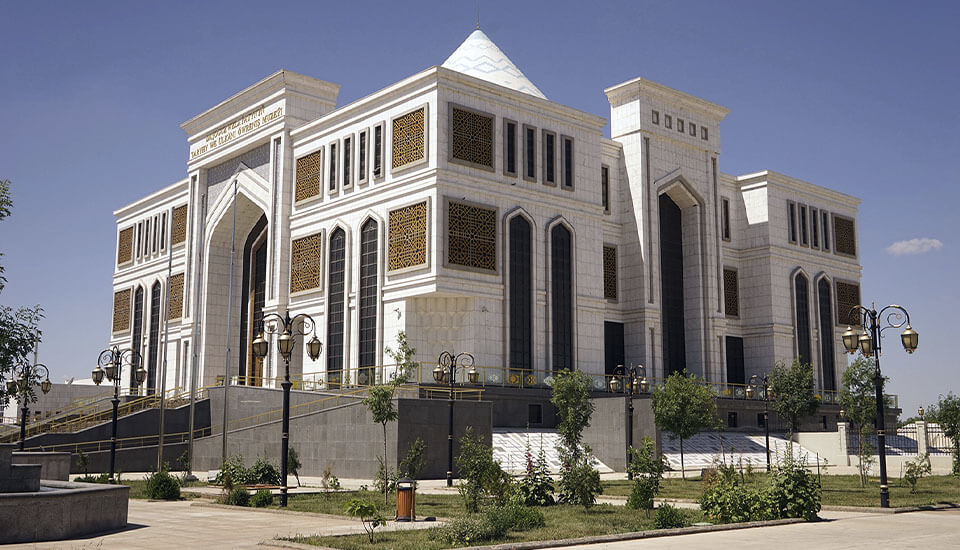Ashgabat
Alem Ferris wheel
State Museum
Fine Arts museum
Wedding Palace
Nisa fortress
Memorial Complex
Ertogrul Gazi Mosque
Neutrality monument
Independence Park
Turkmenbashi Ruhy Mosque
Olympic Village
Ylham Alley
Carpet Museum
Monument of Lenin
Ahal Region
Abivert
Altyn Depe
Annau
Darvaza
Geokdepe
Kowata
Mane baba
Zengi baba
Nedir Shah
Nokhur
Parzdepe
Sarahs baba
Seyit Jemaleddin mosque
Shahrislam
Ulug depe
Mary region
40 cupolas
Akcha Kala
Ancient Merv
Badkhyz
Chilburj
Gebeklytepe
Geok Gumbaz
Gurtly Depe
Kharoba Koshuk
Talkhatan Baba
Yekedeshik
Dashoguz region
Ashyk Aydyn Pir
Devkeshen
Ismamit ata
Kalaly-gyr
Kaplankyr Nature Reserve
Kunya-Urgench
Damla
Balkan region
Dehistan
Yangikala
Awaza
Gozli ata
Kemal ata
Mashat ata
Paraw bibi
Lunar Mountains
Shevlan Baba
Igdy kala
Kunya-Urgench has a very special place in the unique constellation of the ancient cities in Central Asia. It is located 105 km north-west of the administrative centre of Dashoguz Velayat – the city of Dashoguz. The region (total area of 73430 km 2 ) is situated on the left bank of the Amu Darya in the north of Turkmenistan. The Karakum Desert occupies the major part of its territory.
Kunya-Urgench is included in the UNESCO World Cultural Heritage List and is one of the most significant historical and archaeological monuments in Dashoguz Velayat. The city was called differently in the Middle Ages. The Arabs reinterpreted its ancient national name ‘Gurgan’, ‘Gurganch’ or ‘Gurganj’ in ‘Jurjaniya’ in the 8th century. The name ‘Urgench’ was introduced under the Mongol rule in the 13th century. In the 17th century, the inhabitants left the city and moved to another place, 190 km southeast, called ‘Yangi Urgench’ (meaning ‘New Urgench’). Thus, the distinctive attribute ‘Köne’ (meaning ‘Old’) was supplemented to the name of Urgench. The city became an impregnable fortress against the Genghis Khan’s army. Architects and builders from Kunya-Urgench erected beautiful buildings for Tamerlane in Samarkand. The surviving monuments, including in the Turabek Khanum Mausoleum (the 14th century), Sultan Tekesh Mausoleum (the 12th century), Il Arslan Mausoleum (the 12th century), the Kutlug Timur Minaret (the 11th-14th centuries) and other unique, admirable and recognized landmarks belong to the masterpieces of the world medieval architecture. The Nejmeddin Kubra Mausoleum with the ancient necropolis, which is popularly called ‘Uch yuz altmysh’ (from Turkmen ‘360 saints’), is a global centre of the mass pilgrimage for Muslims.
The travellers, who are on a pilgrimage tour, take a great interest in the mausoleum, which is a place of worship for Ismamut Ata. He is believed to be a contemporary and follower of the Prophet Muhammad and one of the founders of Islam in Turkmenistan. This historical landmark is located on the southern boundary of the Horezm oasis, where the ancient settlement of Ishrat Gala was founded in the 11th-12th centuries. Two mosques, a mausoleum, a madrasah and a small group of administrative buildings that have survived here remind of this once flourishing medieval sanctuary. The trips to the Izmukshir Fortress, known since ancient times, with the largest and most picturesque fortress ruins of the Horezmshah Empire, are always interesting and informative. The great Turkmen writer, thinker, theologian, expert of the Islamic world, Mahmyt Zamahshary wrote outstanding scientific works, lived and worked here in the 11th-12th centuries. The majestic ancient walled cities are also located here. For example, the medieval settlement Diyarbekir (Yarbekir Gala) is situated about 90 km to the west of Dashoguz. Another grandiose settlement Dev Kesken Gala represents the ruins of the ancient city of Vazir. The settlement was built on the banks of the Amu Darya River’s canals, about 60-70 km in the north-west of Kunya-Urgench.
Dashoguz Velayat attracts travellers because one of the largest meteorites in the 20th century fell near Kunya-Urgench in June, 1998. The meteorite is the third largest in the world and the largest in the CIS countries. Its weight is almost a ton, and its age is over 4 billion years. The celestial body crashed into the ground to a 4-metre depth and formed a 6-metre crater.
People can discover the rich natural world of Velayat by visiting the Gaplankyr State Nature Reserve. The main task of the Reserve is to protect the birds living on Sarygamysh Lake, as well as to increase the number of gazelles, mountain sheep and saigas. Moreover, ‘gaplankyr’ is translated from Turkmen ‘tiger plateau’ and is associated with a large cat – the cheetah, which formerly inhabited the region.


